 Ancient Aztec art played a significant role in religious expression and honoring their gods. This form of art was used for various forms for communication. The Aztecs called their form of art toltecat, which originated from a group of people known as the Toltecs. The Toltecs, literally meaning a group of skilled craftsmen, were very skilled artisans. Those who were referred to as a Tolteca or Toltec were privileged and honored because they were talented artisans of the artistic traditions of the golden era. The artisans expressed their form of arts through drawings, sculptures and pottery.
Ancient Aztec art played a significant role in religious expression and honoring their gods. This form of art was used for various forms for communication. The Aztecs called their form of art toltecat, which originated from a group of people known as the Toltecs. The Toltecs, literally meaning a group of skilled craftsmen, were very skilled artisans. Those who were referred to as a Tolteca or Toltec were privileged and honored because they were talented artisans of the artistic traditions of the golden era. The artisans expressed their form of arts through drawings, sculptures and pottery.The Aztecs used pictographs as a form of representing objects or sounds. This was a famous form of ancient art used extensively within their counting system. The Aztecs counting system was establish off of a base-20 counting system, unlike our modern base-10 counting system (Aztec-Indains). Pictures of objects were used to represent a number. For example, a picture of a fir tree was used to represent the number 400. These pictographs were an advanced form of Aztec art that was used torecord Aztec history and to carry out business agreements. They also portrayed recent conquests, sacrifices, or daily life duties.
Along with artistic pottery designs, the Aztecs used sculptures to convey their strong belief in religion. These sculptures were made of different kinds of stones such as jade, obsidian and quartz (Aztec-Indians). The craftsmen would spend long hard working days carving self-supporting idols that represented their gods or sacrificial victims. These sculptures were placed throughout their temples. The animals and significant leaders were carved in all different sizes and shapes looking extremely realistic. The most famous and well-known sculpture in the Aztec art history would be the Aztec stone calendar. This astonishing historical piece of art has a diameter of 12 feet and the sun god can be located in the center of this stone piece (Aztec-Indains). Circular bands can be found around the center of the sun god representing the heavens and days around the face (Aztec-Indains). This unique calendar was considered to be the agricultural calendar and it was very sacred for the Aztecs.
 Most of the ancient Aztec art had a variety of themes and common types of art. Each unique sculpture had its own characteristic. Some of the themes of art depicted animal figures such as; insects, birds, fish, and jaguars (Aztec-History). The Aztecs had a great appreciation for a variety of animals. The majority of animals represented religious gods. The Aztecs used vivid, sharp, gaunt colors to represent the gods. A variety of art in the empire was embellished with jewels and feathers (Aztec-History). The emperor had a headpiece that was adorned with bright green feathers, gold and blue (Aztec-History). Rich families were seen with earrings, bracelets and necklaces covered in vibrant colors. Aztec art was generally created with gold, silver, copper, jewels, feathers, coral, clay, and stone (Aztec-History). The characteristics of each art were demonstrated as being extremely realistic, yet most of it depicted death itself. This reflects the Aztecs infatuation in avoidance of death and disaster by making death art, so that they could conquer it if it came to them in their future.
Most of the ancient Aztec art had a variety of themes and common types of art. Each unique sculpture had its own characteristic. Some of the themes of art depicted animal figures such as; insects, birds, fish, and jaguars (Aztec-History). The Aztecs had a great appreciation for a variety of animals. The majority of animals represented religious gods. The Aztecs used vivid, sharp, gaunt colors to represent the gods. A variety of art in the empire was embellished with jewels and feathers (Aztec-History). The emperor had a headpiece that was adorned with bright green feathers, gold and blue (Aztec-History). Rich families were seen with earrings, bracelets and necklaces covered in vibrant colors. Aztec art was generally created with gold, silver, copper, jewels, feathers, coral, clay, and stone (Aztec-History). The characteristics of each art were demonstrated as being extremely realistic, yet most of it depicted death itself. This reflects the Aztecs infatuation in avoidance of death and disaster by making death art, so that they could conquer it if it came to them in their future.
Reference:
Aztec Art. The Paintings, Drawings, Sculptures, and Pottery of the Ancient Aztecs. All Content
© 2010 Aztec-Indians.com.
http://www.aztec-indians.com/aztec-art.html
No comments:
Post a Comment